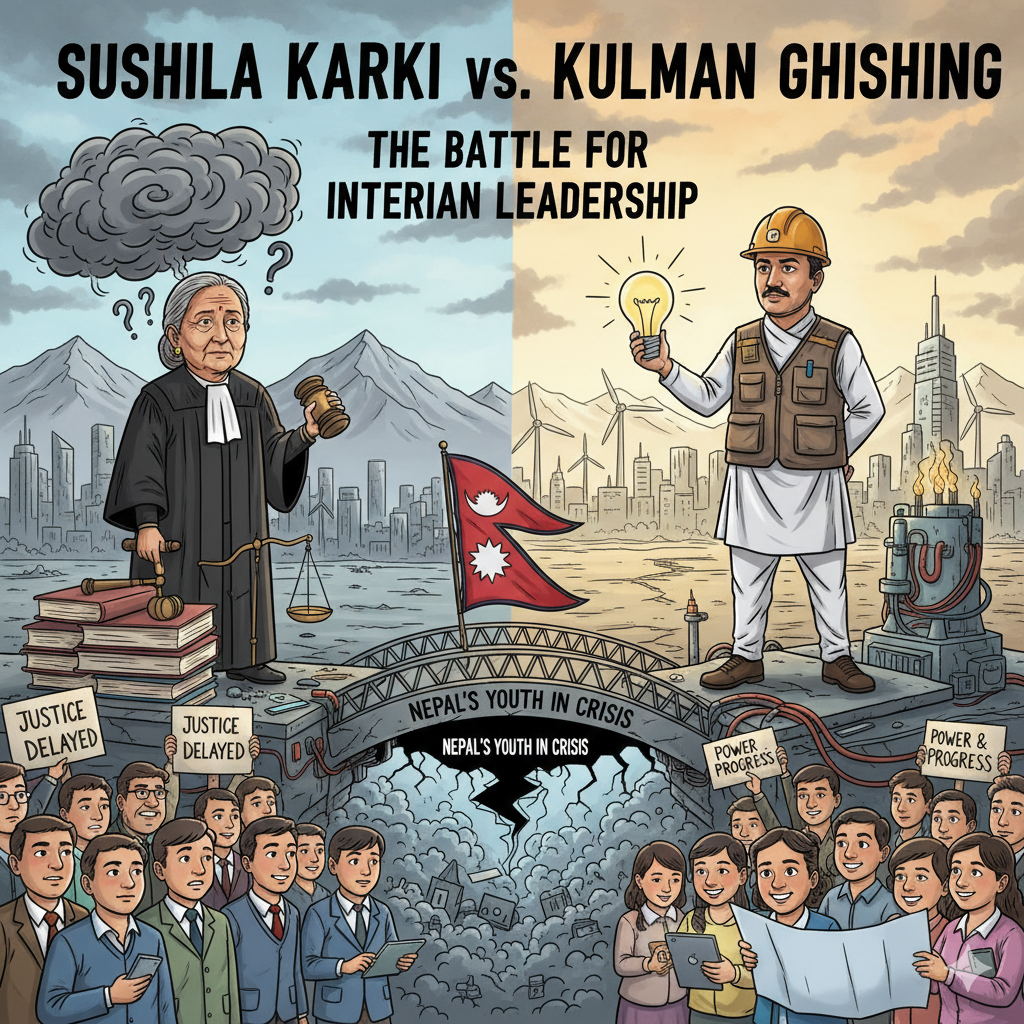Nepal Crisis: Sushila Karki vs. Kulman Ghising – The Battle for Interim Leadership
Amid escalating turmoil in Nepal, where ongoing protests have resulted in the tragic deaths of 31 individuals, the nation finds itself at a pivotal crossroads. As activists push for significant governmental changes following the resignation of Prime Minister KP Sharma Oli, the burgeoning Gen Z movement is faced with a crucial decision: who will lead the interim government? The spotlight is currently on two potential candidates, Sushila Karki and Kulman Ghising, each representing different visions for the future of the country.
Gen Z’s Growing Role in the Crisis
The unrest in Nepal erupted recently, leading to violent confrontations between protesters and authorities. These demonstrations were largely driven by young people who have grown disillusioned with the existing political structure. This discontent has not only led to calls for a new government but has also significantly shifted the way political power dynamics are perceived. Much of the youth feels that the old guard has failed them, necessitating fresh leadership that aligns with their demands for change.
In a dramatic turn of events, former Chief Justice Sushila Karki emerged as the initial frontrunner to lead a transitional government. Reports from Kathmandu on Wednesday indicated that Karki, a well-known anti-corruption activist, has begun discussions with the Nepal Army, which currently holds temporary control of the government. Support for her candidacy has been strong among protesters, with many lauding her integrity and commitment to reform. One protester, Sujit Kumar Jha, expressed confidence in Karki’s abilities, stating, “We see Sushila Karki for who she truly is – honest, fearless, and unshaken. She is the right choice.”
Karki’s potential appointment holds symbolic significance as well; not only would she be the first woman to assume the role of Prime Minister in Nepal, but her leadership could also signify an era defined by accountability and transparency—qualities deeply sought after by the younger generation.
The Shift Towards Ghising
However, just 24 hours after Karki’s candidacy gained notable traction, an internal faction of Gen Z protesters pivoted towards Kulman Ghising, a retired electrical engineer credited with successfully addressing Nepal’s chronic power outages. This sudden change in leadership preference raised eyebrows and revealed the underlying tensions within the protest movement. The faction argued that constitutional restrictions prevent Karki, as a retired judge, from holding any government office outside the judiciary. They also deemed her “too old” to represent Gen Z’s aspirations effectively.
Ghising’s support as a “patriot” who easily communicates with the military suggests that the movement is looking for pragmatism in leadership amid chaotic circumstances. His rise as a potential leader reflects both a desire for effective governance and a broader initiative to distance the new generation from the entrenched political establishment.
Clashes and Disagreement Among Protesters
The discord over leadership choices has not only sparked debates among protesters but has also led to physical confrontations within their ranks. Reports of clashes between factions underscore the complexity of the situation, as differing ideologies and priorities come to the forefront. Instead of opposing the authorities, some groups are now struggling to unify their own ranks.
Both Karki and Ghising illustrate the generational divide in political leadership preferences. While Karki signifies a push for integrity and honesty rooted in judicial experience, Ghising represents a practical and technical approach, aiming to bring stability to a government in turmoil. As the protests evolve, these disagreements may further complicate the already delicate political landscape in Nepal.
Navigating Constitutional Challenges
One of the foremost challenges for Karki, Ghising, or any other proposed leader lies within the framework of Nepal’s Constitution. Established in 2015, the constitution mandates that a new Prime Minister must be chosen from a party or alliance with a parliamentary majority, which complicates the transition toward a new interim government significantly. Despite these challenges, political figures—including President Ram Chandra Paudel—have stated their commitment to finding solutions that align with constitutional guidelines while addressing the demands of the protesters.
President Paudel recently urged parties to maintain confidence during this turbulent period, indicating that efforts are underway to navigate through the constitutional roadblocks. “I am making every effort to find a way out of the current difficult situation in the country within the constitutional framework,” he stated. This aligns with the aspirations of Gen Z protesters who, despite their desire for change, have indicated that they do not wish to overhaul the Constitution entirely.
Broader Implications for Nepal’s Political Landscape
The ongoing unrest and the Gen Z movement’s push for new leadership could signal a paradigm shift in Nepal’s political landscape. Young leaders such as Kathmandu Mayor Balendra ‘Balen’ Shah, who remains a consensus candidate among various factions, reflect a growing trend for youth engagement in politics. However, Shah has expressed reservations about assuming the role of interim Prime Minister, instead supporting Karki’s nomination.
As protesters continue to demand an interim government, it is clear that the ties to former political figures like KP Sharma Oli and Sher Bahadur Deuba are severed, as many blame them for the current crisis. Such sentiments suggest a fundamental shift away from traditional political alliances and an inclination towards fresh, youthful individuals in leadership roles.
Looking Ahead: What This Means for Nepal
The emerging tension between different factions within the protest movement, coupled with the challenges posed by the constitutional framework, will shape Nepal’s political future. While Karki and Ghising represent differing paths for interim leadership, a broader conversation about governance, representation, and the role of the youth in shaping Nepal’s future is at the forefront.
As the situation evolves, the international community watches closely. Continued violence and unrest could have lasting implications on stability and governance in Nepal. For now, it remains to be seen which leader will emerge as the favored choice to guide the nation through this critical juncture. With the stakes rising, one thing is certain—Nepal’s youngest generation is determined to carve out their own political destiny.


